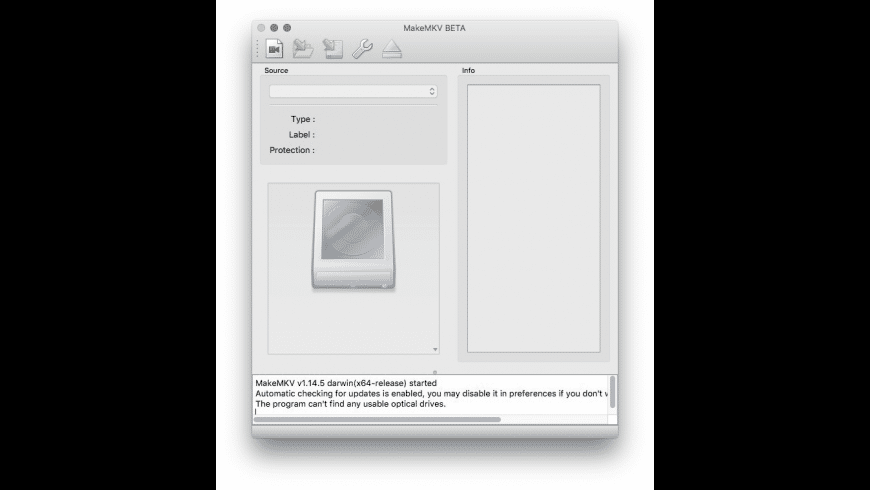
- #MAKEMKV FOR MAC HOW TO#
- #MAKEMKV FOR MAC MOVIE#
- #MAKEMKV FOR MAC SOFTWARE#
- #MAKEMKV FOR MAC SERIES#
#MAKEMKV FOR MAC HOW TO#
I won’t go into detail here about how to do this. If you do want to convert your video to an Apple-compatible format that you can add to your iTunes library, play on an Apple TV, and sync to an iOS device, it’s time to use HandBrake.
#MAKEMKV FOR MAC SERIES#
If you click the disclosure triangle next to the disc, you can choose to exclude different parts of a disc, such as the main feature and bonuses, or different episodes for a TV series you can also exclude any audio and subtitle tracks you don’t need.

The MakeMKV interface lets you select which elements from a disc you want to rip. MakeMKV will read the disc, then display its contents. Launch MakeMKV, insert a disc in your optical drive, then click the big button that looks like an optical drive.
#MAKEMKV FOR MAC SOFTWARE#
While macOS doesn’t support Blu-ray discs, any software that can read such discs will be able to do so from this drive, or any other. I have long used the Pioneer BDR-XD05B, which is a bus-powered drive (it doesn’t need a separate power supply) that supports USB 3. Torn paper/disk image courtesy of Shutterstock.You’ll need an optical drive to rip DVDs, and if you want to rip Blu-rays, you’ll need a Blu-ray drive (which can also rip CDs and DVDs).
#MAKEMKV FOR MAC MOVIE#
Here at TMO Towers in the US it has yet to be tested to see whether or not one actually has the right to back up a movie that one purchased). (As always, check your local laws before ripping disks. If your Mac doesn't already have a Blu-ray drive (and most don't, since none come from the factory that way), I've had 100% success with this USB Blu-ray player for US$42 from Amazon. That's it! From then on Handbrake will attach to your Blu-ray disks via these MakeMKV libraries, and you can use it just like you would with any other disk. So that you know what you're asking your computer to do, the 'cd' command just changes your directory (with ~ meaning "home"), the 'mkdir' command just creates a new folder and the 'ln -s' command creates a symlink (similar to a shortcut) to make these libraries visible in a spot that OS X would look. Ln -s /Applications/MakeMKV.app/Contents/lib/libmmbd.dylib ~/lib/libbdplus.dylib Ln -s /Applications/MakeMKV.app/Contents/lib/libmmbd.dylib ~/lib/libaacs.dylib The instructions (from this MakeMKV thread, also penned by Mike Chen) are to go to the Terminal and type the following (each of the 4 commands on their own separate line, followed by return): cd ~ This is the magic that will let Handbrake see your Blu-ray disks directly. Once you've copied MakeMKV to your Applications folder, you need to point the OS at a special library baked inside of MakeMKV.

You can get an updated key at any time during this extended beta directly from MakeMKV (or, you know, you can buy it and support its development ). The first two are completely free, the last is a paid app but Mike Chen, MakeMKV's author, has said that all of its features will remain free while in beta. To do this, you first need to download and put Handbrake, VLC and MakeMKV into your Mac's Applications folder. What many users don't realize, though, is that MakeMKV can be invoked on-the-fly to allow Handbrake to rip and convert/compress Blu-ray disks directly. MakeMKV is one such program that will do that Blu-ray conversion. Typically you need to first rip the Blu-ray into some format that Handbrake will understand and then you can convert/compress from there. If you also have VLC installed Handbrake will read DVDs and convert them directly.īlu-ray, disks, however, are not supported directly by this Handbrake/VLC combo, and that makes things frustrating. Handbrake is an excellent tool that allows you to take a movie and convert/compress it into a Mac-and-iOS-playable movie file.


 0 kommentar(er)
0 kommentar(er)
